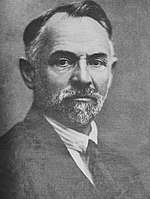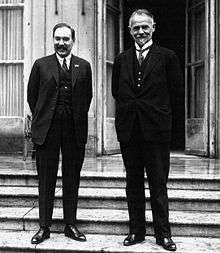Leonid Krasin
Leonid Borisovich Krasin (Russian: Леони́д Бори́сович Кра́син; 15 July 1870 – 24 November 1926) was a Russian engineer, social entrepreneur, Bolshevik revolutionary politician and a Soviet diplomat.
Leonid Krasin | |
|---|---|
 | |
| People's Commissar for Foreign Trade | |
| In office 6 July 1923 – 18 November 1925 | |
| Succeeded by | Alexander Tsiurupa |
| People's Commissar for Trade and Industry | |
| In office November 1918 – June 1920 | |
| People's Commissar for Transport | |
| In office March 1919 – December 1920 | |
| Personal details | |
| Born | 15 July 1870 Kurgan, Tobolsk Governorate, Russian Empire |
| Died | 24 November 1926 (aged 56) London, United Kingdom |
| Citizenship | Soviet |
| Political party | RSDLP (1898-1903) RSDLP (Bolsheviks) (1903-1912) Russian Communist Party (1912-1926) |
Early years
Krasin was born in Kurgan, Tobolsk Governorate in Siberia. His father, Boris Ivanovich Krasin, was the local chief of police. The young Leonid was a star pupil at school, and met the American explorer George Kennan when he visited Siberia.[1] Krasin joined the Social Democratic Labor Party during the 1890s. Arrested towards the end of the 1890s, he was sent to internal exile in Siberia where he worked as a draughtsman on the Trans-Siberian Railway. He graduated from Kharkov Technological Institute in 1901.
Political activism
In the 1903 split into Mensheviks and Bolsheviks, Krasin supported the latter, and was elected to the Central Committee the same year.
On his release from exile in 1900 he moved to Baku, where Joseph Stalin was also active at the time. While there, Krasin used his financial contacts to help establish an illegal printing press which was the main vehicle for Vladimir Lenin's newspaper. He left Baku in 1904 to work as the chief engineer of Savva Morozov.

His activities during the 1905 Revolution were primarily in sourcing finance for the Bolshevik revolutionaries, including organizing bank robberies. Krasin helped organize the 1907 Tiflis bank robbery, a bloody crime that took place in the middle of Yerevan Square, killing forty and injuring 50.
Krasin enjoyed the excitement of terrorism. His home was the main laboratory from which were manufactured the bombs used to attack Prime Minister Pyotr Stolypin.[2]
The quest for excitement caused a break with Lenin. Lenin, who was usually acerbic in such circumstances, remained complimentary towards Krasin, and continued to exhort him to rejoin the Party.[3]
In 1908 he left Russia and in 1909 collaborated with Alexander Bogdanov in the launch of Vpered. Later he withdrew from political activities for many years. He had a successful career as an electrical engineer, becoming a millionaire. After the February Revolution of 1917 he returned and rejoined the Bolsheviks.[4] In the Russian Bolshevik government Krasin was People's Commissar of Foreign Trade from 1920 to 1924.
Diplomatic career
Krasin met E. F. Wise in Copenhagen in April 1920. Wise was representing the Supreme Economic Council. It was in this capacity that he negotiated and signed the Anglo-Soviet Trade Agreement of March 1921. In 1924 he was elected to the Communist Party's Central Committee, an office he held until his death. In 1924, he became the first Soviet Ambassador to France. He left a year later for London, where he died.
Role in project of Lenin's tomb

Krasin, in the tradition of Nikolai Federov, believed in immortalization by scientific means. At the funeral of Lev Karpov in 1921, he said:
I am certain that the time will come when science will become all-powerful, that it will be able to recreate a deceased organism. I am certain that the time will come when one will be able to use the elements of a person's life to recreate the physical person. And I am certain that when that time will come, when the liberation of mankind, using all the might of science and technology, the strength and capacity of which we cannot now imagine, will be able to resurrect great historical figures- and I am certain that when that time will come, among the great figures will be our comrade, Lev Iakovlevich.[5]
Shortly after Lenin's death he wrote an article on "The Immortalization of Lenin" and proposed a monument containing Lenin's corpse that would become a center of pilgrimage like Jerusalem or Mecca. Krasin, along with Anatoly Lunacharsky, announced a contest for designs of the permanent monument/mausoleum. Krasin also attempted unsuccessfully to cryogenically preserve Lenin's body.[6]
Death
While Krasin was negotiating formal recognition of the Bolshevik government by the United Kingdom and France, and despite remedies proposed by his old friend, the physician Alexander Bogdanov, he died from a blood disease. Krasin's funeral procession three days later included 6,000 mourners, many of them Bolshevik sympathizers; he was cremated at Golders Green Crematorium before being buried at the Kremlin Wall Necropolis in Moscow.
His London position was filled by Christian Rakovsky.
Two icebreakers (one launched in 1917 and one in 1976) commemorated Krasin.
During the Great Purge and until Stalin's death he was largely omitted from the history of the Communist Party and the Soviet government.[7]
His daughter Liubov married French politician and diplomat Gaston Bergery, from whom she was divorced in 1928. After the war she married French politician and journalist Emmanuel d'Astier de La Vigerie.
Texts
- "Our Trade Policy", Labour Monthly, Vol II, No.1, January 1922
- Archive of Leonid Borisovič Krasin Papers at the International Institute of Social History
Notes
- Glenny, Michael (Oct 1970). "Leonid Krasin: The Years before 1917. An Outline". Soviet Studies. Taylor & Francis, Ltd. 22 (2): 192–221. doi:10.1080/09668137008410749. JSTOR 150054.
- Felshtinsky, Yuri (2003). Preface to Leonid Krasin: Letters to His Wife and Children (in Russian). Archived from the original on 2011-07-11.
- Adam Ulam Stalin: The Man and His Times
- 'The Anglo-Soviet Trade Agreement, March 1921', M. V. Glenny, Journal of Contemporary History, Vol. 5, No. 2. (1970), pp. 63-82.
- Tumarkin, Nina (1981). "Religion, Bolshevism, and the Origins of the Lenin Cult". Russian Review. 40 (1): 35–46. doi:10.2307/128733. JSTOR 128733.
- John Gray, The Immortalization Commission, 2011, pp. 161-166.
- Roy Medvedev, Let History Judge, 1971
External links
| Wikimedia Commons has media related to Leonid Krasin. |